Professional Reference Shelf
Topics
- Exploring the Problem
- Present State/Desired State
- Dunker Diagram
- Statement-Restatement Techniques
- Closed-Ended Algorithm
| Exploring the Problem |
top
|
| This technique works well, both for situations of analyzing incorrectly defined problems assigned to you, and for formulating problem statements for new problems you uncover yourself. Once presented with a problem, we want to explore all aspects of the problem and its surroundings. This technique, which has its origins in the McMaster Five-Point Strategy given in Appendix 1, is a procedure that guides us to understand and define the real problem. Gathering information is also the key to the success of the exploration, and the first four steps are very helpful in this process. |
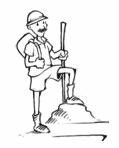
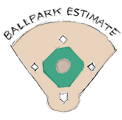
|
- Identify all available information
- Recall or learn pertinent theories and fundamentals
- Collect missing information
- Solve a simplified version of the problem to obtain a "ballpark" answer
- Hypthesize and visualize what could be wrong with the current situation
- Brainstorm to guess the answer
- Recall past or related problems and experiences
- Describe or sketch the solution in a qualitative manner or sketch out a pathway that will lead to the solution
- Collect more data and information
- After using some or all of the activities above, write a consise statement defining the real problem.
|
Exploring the Problem" can also be used to build upon the results of the previous technique "Finding Out Where the Problem Came From.". Let's apply this heuristic to the dead fish problem.
| Example: The Case of the Dead Fish |
top
|
 Stan decides to initiate his own investigation into the dead fish problem over the weekend.
Stan decides to initiate his own investigation into the dead fish problem over the weekend.
| 1. |
Identify Available Information: There is a toxic discharge from the plant, the river level is low, and there are a large number of dead fish in the river. |
| 2. |
Recall Past Experiences and Learn Fundamentals: Stan calls a friend in the biology department at the local university and asks her about the problem of what could be causing the fish to die. She tells Stan that the extremely low water levels lead to significantly warmer water temperatures, and hence lower levels of dissolved oxygen in the water. These conditions make the fish susceptible to disease. |
| 3. |
Collect Missing Information: Secondly, she says that a fungus has been found in two nearby lakes that could be responsible for the death of the fish. Upon checking the recent daily temperatures, Stan learns that the day before the fish began dying was one of the hottest of the decade. Stan starts making phone calls to people upstream and downstream from the plant and learns that dead fish are appearing at the same unusually high rate everywhere, not just downstream of the plant. |
| 5. |
Hypothesize: The fish were dying all over the area as a result of the fungus, and not from the plant discharge. |
| 9. |
Collect More Information: Upon examination of the dead fish, it was discovered that the fungus was indeed the cause of death, and that toxic chemicals played no role in the problem. Stan was glad that he had found out where the problem had come from and had explored the situation rather than blindly proceeding to design the treatment plant. |
| 10. |
Write a Concise Problem Statement to Define the Real Problem: Identify ways to cure the infected fish and prevent healthy fish from being infected. |
| Example: A Real Tooth Ache |
top
|
Dr. Lake in A Real Toothache employed and or initiated the steps below to find the true cause of his practice's problem.
| 1. |
Identify Available Information:50 employees have left the company in the past 13 months; a new complex computer system was installed 16 months ago, and Cindy was promoted to office manager at that same time. |
| 5. |
Hypothesize: After hearing Cindy's possible causes for the turnover problem Dr. Lake hypothesized that a hostile work environment and the complex computer system where indeed the causes of the turnover problem. |
| 3. |
Collect Missing Information: Dr. Lake met with Penny, the long time nurse who had recently quit, to determine her reason for leaving. From this meeting he learned that Penny's reason for leaving was the manor in which Cindy was managing the office. He also learned that Penny felt that the office staff did not receive adequate training for the computer system that was installed which was leading to great frustration for the employees. |
| 6. |
Write a Concise Problem Statement to Define the Real Problem: Find a replacement for Cindy.
|
| Example: De-bottlenecking a Process (Heat Exchanger) |
top
|
Even though the following example is taken from an actual case history, don't worry if you don't know much about heat exchangers; just follow the reasoning. It is too good an example to pass up. The Situation: A valuable product was being sold as fast as it could be manufactured in a chemical plant. Management tried to increase production but was unable to do so. Analysis of each step in the production line showed that the bottleneck was the refrigeration unit. This unit was a simple heat exchanger in which the hot liquid stream was cooled by passing it through a pipe which contacted a cold liquid stream. Heat flowed from the hot stream through the pipe wall into the cold stream. Unfortunately the refrigeration unit (i.e., heat exchanger) was not cooling the hot liquid stream to a sufficiently low temperature
for it to be treated effectively in the next processing step. The instructions given to solve the perceived problem: "Design and install a larger refrigeration unit." The design of a larger refrigeration unit was started.

Explore Phase
- Identifying inputs/outputs: Cold liquid stream not cooling hot product stream.
- Recall related theories and fundamentals: The rate of cooling between the two streams is related to the temperature difference between the two streams, their flow rates, and the materials and condition of the unit.
- Collect missing information: What is the size of the current refrigeration unit? What are the entering and exiting temperatures of the liquid streams?
- Carry out an order of magnitude calculation: AH HA! The new unit need be no larger than the old one.
- Hypothesize and visualize what could be wrong with the current system: Inefficient operation of current system? Could something be increasing the resistance to heat transfer (i.e., insulating)?
- Guess the result: Could scale (minerals deposited from the liquid) have built up on the inside of the unit acting as an insulating blanket?
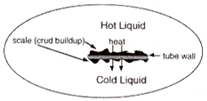 |
The buildup of scale on the pipe walls of the exchanger reduces the amount of heat that will
transfer from the hot fluid to the cold fluid which severely degrades the ability of the exchanger to perform its intended task. The thicker the scale, the greater the resistance to heat transfer and the poorer the performance of the unit. |
- Recall past problems, theories, or related experiences: Scale greatly reduces the efficiency of the unit.
- Sketch solution or solution pathway: Examine the unit for evidence of scale or fouling that may be reducing the heat transfer efficiency.
- Collect more data: An examination of the heat exchanger showed it was indeed badly fouled.
- Define the real problem: The scale on the pipe wall must be removed in order to cool the product stream effectively.
| Present State/Desired State |
top
|
The present state/desired state technique is a means to determine the real problem by first describing the present state (where you are)
and then describing the desired state (where you want to go).
The descriptions of these states are reworked until each concern and need identified in the present state is addressed in the desired state.
How many times have you heard the statement "You can get there from here?" The Present State/Desired State technique helps us verbalize
where we are and where we want to go, so an appropriate path can be found and we can indeed get there from here.
The Present State/Desired State technique also helps us learn whether the solution goals (Desired State) are consistent with our needs (Present State).
When writing the Desired State statement, avoid using ambiguous and vague words or phrases like "best", "minimal", "cheapest", "within a reasonable time",
"most efficient", etc. because these words mean different things to different people. Be quantitative where possible.
It is important that the Present State statement match the Desired State statement. In order for the Present State and Desired State to match,
every concern in the Present State should be addressed in the Desired State. In addition, the Desired State should not contain solutions to problems
that are not in the Present State. Sometimes a match exists, but it really doesn't get to the heart of the problem or allow many solution alternatives.
Reworking the Present State and Desired State statements until they match is a technique that increases the probability of arriving at the true problem statement.
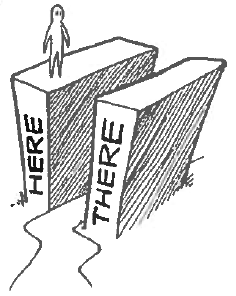
| Example: Missing the Mark |
top
|
During World War II, a number of aircraft were shot down while engaging in bombing missions over Germany.
Many of the planes that made it back to base safely were riddled with bullet and projectile holes.
The damaged areas were similar on each plane.
The following instructions were given to solve the perceived problem:
"Reinforce these damaged areas with thicker armor plating."
 Round 1
Round 1
| Present State |
Desired State |
| Many bullets/projectiles penetrating aircraft |
Fewer planes being shot down |
This is not a match because many surviving planes also have bullet holes. There is not a one-to-one mapping of the needs of the present state being addressed and resolved in the desired state.
Round 2
| Present State |
Desired State |
| Many bullets/projectiles penetrating aircraft |
Fewer bullet holes |
These states are matched, but the distinction between the present state and the desired state is not clear enough. It may take only a single bullet hitting a critical area to down a plane.
Round 3
| Present State |
Desired State |
| Many bullets/projectiles penetrating aircraft in critical and noncritical areas |
Fewer bullets/projectiles penetrating critical areas |
These two statements now match and the distinction between them is sharp, opening up a variety of solution avenues, such as reinforcing critical areas, moving critical components (e.g., steering mechanisms) to more protected locations, and providing redundant critical components.
The original instructions given to solve the perceived problem would have failed.
Reinforcing the areas where returning planes had been shot would have been futile.
Clearly, these were noncritical areas; otherwise, these planes would have been casualties as well.
A more appropriate problem statement can now be written as follows:
"Find a way to protect the critical parts of the aircraft from being damaged by projectiles."
The Duncker diagram helps us obtain solutions that satisfy the present state/ desired state statements.
The unique feature of the Duncker diagram is that it contains two major pathways (general solutions) to go from the present state (the problem statement) to the desired state (an acceptable problem solution).
| Example: Kindergarten Cop |
top
|
Linda Chen, who has been teaching elementary school for 25 years, has just finished a six-month leave of absence and is scheduled to return to teaching in February. She is dreading going back to work because the last few years have been extremely stressful and difficult, and she feels burned out teaching kindergarten. Students seem harder to control, which makes Linda feel more like a policewoman than a teacher.
Linda doesn't like the materials she is required to use in the classroom, and the parents of her students don't seem to take much interest in their children's education. She also enjoyed the time she had to herself during her six-month leave and strongly feels she must continue to have more time to herself as she nears retirement. Linda must wait five years to retire if she is to receive full benefits.
Thus Linda's present state is to return to teaching, and her desired state is to not return to teaching. Prepare a Duncker diagram to analyze this situation.
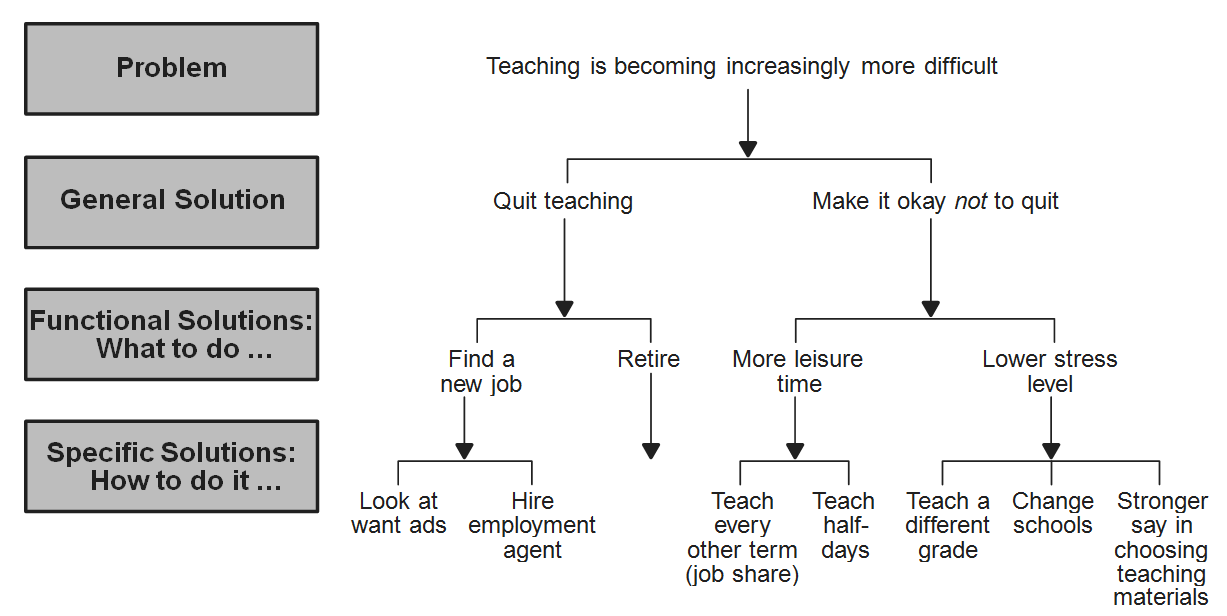
Upon analyzing her situation using a Duncker diagram, Linda discovered the real problem: The unruly classes she had the year before her six-month leave put her under a large amount of stress. Consequently, with the aid of a Duncker diagram, she arrived at the conclusion that the real problem was that she needed to find ways to lower her stress level at her workplace by teaching a different grade.
Linda's new problem statement is "If possible, find a grade to teach next year that will lower her stress at her workplace."
| Example: To Market, To Market |
top
|
Toasty O's was one of the first organic cereals without preservatives when it first came on the market. After several months, however, its sales dropped. The consumer survey department was able to identify that customer dissatisfaction was expressed in terms of a stale taste. The company's management then issued the following instructions to solve the perceived problem: "Streamline the production process to get the cereal on the store shelves faster, thereby ensuring a fresher product."
Unfortunately, there wasn't much slack time that could be removed from the produc- tion process to accomplish this goal. Of the steps required to get the product on the shelves (production, packaging, storage, and shipping), production was one of the fastest. Thus the company considered plans for building plants closer to the major markets, as well as plans for adding more trucks to get the cereal to market faster. The addition of either new plants or more trucks would require a major capital investment to solve the problem.
Let's develop a Duncker diagram for this problem
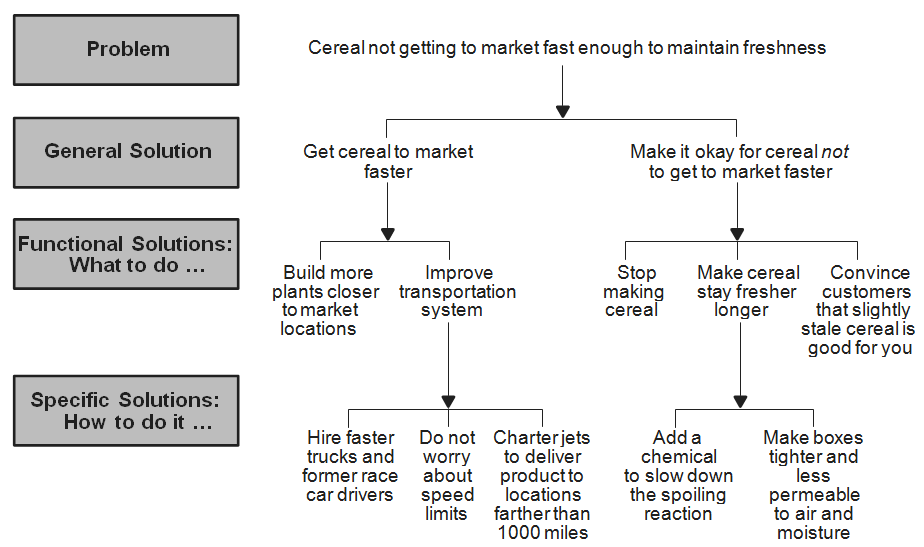
Of course, the real problem was that the cereal was not staying fresh long enough- not that it wasn't reaching the stores fast enough. Keeping the cereal fresher longer was achieved by improved packaging and the use of additives to slow the rate at which Toasty O's became stale.
The new problem statement is this: "Find how to best improve packaging to keep the cereal fresher longer."
| Statement-Restatement Techniques |
top
|
The statement-restatement technique developed by Parnes is a method to evolve the problem statement to its most accurate representation of the problem.
Problem Statement Triggers
Trigger 1. Vary the stress pattern - try placing emphasis on different words and phrases.
Trigger 2. Choose a term that has an explicit definition and substitute the explicit definition in each place that the term appears.
Trigger 3. Make an opposite statement, changing positives to negatives, and vice versa.
Trigger 4. Change "every" to "some," "always" to "sometimes," "sometimes" to
"never," and vice versa.
Trigger 5. Replace "persuasive words" in the problem statement such as "obviously," "clearly," and "certainly" with the argument it is supposed to be replacing.
Trigger 6. Express words in the form of an equation or picture, and vice versa.
| Wanted: Exotic Materials, or … ? |
top
|
| The Situation: In the 1960s scientists recognized that there was no available material that would survive the high temperatures generated on the capsule's surface during reentry to the earth's atmosphere. Consequently, a government directive went out to "find a material able to withstand the temperatures encountered on reentry." By the early 1970s no one had produced a suitable material that satisfied the directive, yet we had sent astronauts to the moon and back. How had this achievement been possible? The real problem was to protect the astronauts upon reentry, rather than to find a material that would withstand such high temperatures. Once the real problem was determined, a solution soon followed. One of the scientists working on the project asked a related question: How do meteors eventually reach the earth's surface without disintegrating completely? Upon investigation of this problem, he found that although the surface of the meteor vaporized while passing through the atmosphere, the inside of the meteor was not damaged. This analogy led to the idea of using materials on the outside of the capsule that would vaporize when exposed to the high temperatures encountered during reentry. Consequently, the heat generated by friction with the earth's atmosphere during reentry would be dissipated by the vaporization of a material that coated the outside of the space capsule. By sacrificing this material, the temperatures of the capsule's underlying structural material remained at a tolerable level to protect the astronauts. Once the real problem was uncovered, the scientists solved the problem by using analogies and transferring ideas from one situation to another. |
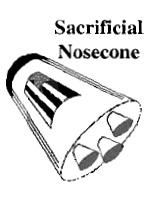 |
Statement-Restatement
The statement-restatement technique might have been used as follows:
Statement 1: Find a material that will withstand the high surface temperature of the capsule resulting from frictional heating upon reentry into the earth's atmosphere.
Restatement I: Find a way to slow the reentry into the earth's atmosphere or to redesign the capsule so that the capsule surface temperature will be lower.
Restatement 2: Find a way to cool the capsule or absorb the frictional energy during reentry so that the surface temperature will be lower.
Restatement 3 Find a way to protect the astronauts on their reentry into the earth's atmosphere.
Restatement 4: Find a disposable material that could surround the capsule and could be sacrificed to absorb the frictional heating.

PERCEIVED PROBLEM:
As land is arid and there is no cultivation, we clearly need to design and build a dam to divert river water inland to irrigate the land.
TRIGGER 1: Vary the stress pattern - try placing emphasis on different words and phrases.
As land is arid and there is no cultivation, we clearly need to design and build a dam to divert river water inland to irrigate the land.
To improve availability of water in the soil, irrigation is required.
As land is arid and there is no cultivation, we clearly need to design and build a dam to divert river water inland to irrigate the land.
What are the various factors that affect growth of agricultural plants? Find various reasons why they are unable to grow here. These may include lack of water, lack of nutrients, excessive salts,etc.
As land is arid and there is no cultivation, we clearly need to design and build a dam to divert river water inland to irrigate the land.
Is irrigation necessary? Is it possible to use the wild plants that already grow there to develop hybrid plants (by genetic engineering) that can grow in arid conditions?
TRIGGER 2: Choose a term that has an explicit definition and substitute the explicit definition in each place that the term appears.
As land is characterized by a severe lack of available water
, and there is no growth of agricultural plants
, we clearly need to design and build a dam to divert river water inland to
artificially supply the land with water.
A study of agricultural crops growing in arid and semi - arid regions in different parts of the world can be made. For example, sorghum and millets are grown as cereals in arid regions. These are hardy crops that can thrive in almost any soil and survive under relatively tough conditions (as little as 500 ml of rain a year). These kinds of plants can be considered as alternatives that can be grown in this region without the need for irrigation.
TRIGGER 3: Make an opposite statement, changing positives to negatives and vice versa.
What are conditions which will cause the death of all plant life?
Absolutely no nutrients, too much salts, heavy metals in the soil can all cause death of plants. The soil should be inspected to make sure that these factors do not kill the plants once sufficient water is provided by irrigation.
TRIGGER 4: Change "every" to "some", "always" to "sometimes", "sometimes" to "never" and vice versa.
Does not apply.
TRIGGER 5: Replace "persuasive words" in the problem statement such as "obviously", "clearly", and "certainly" with the argument it is supposed to be replacing.
As land is arid and there is no cultivation, we clearly need to design and build a dam to divert river water inland to irrigate the land.
As seen in the earlier triggers, lack of water need not be the only reason for the lack of plant life. Other factors such as nutrient levels, salt content and toxins should be considered.
Also as seen earlier, supplying water need not be the only solution even if lack of water is the only problem. For example, we can apply genetic engineering to develop new plants that will grow in the existing conditions. Or, instead of traditional agricultural crops, crops such as millets and sorghum (that are well suited for arid conditions) can be grown.
TRIGGER 6: Express words in the form of an equation or picture, and vice versa.
For plant growth, there is an optimum range of water supply, nutrients, salt contents etc. Anything above or below this range will not be tolerated.

X can represent water level, nutrients, salt level, or toxins
This range varies from plant to plant. The levels of these factors can be measured and a suitable plant can be selected.
CONCLUSION:
From the above, it can be concluded that the REAL PROBLEM statement should be:
Find out why agricultural plants are unable to grow in the arid lands of the New South Wales region and what are the various alternatives available?
Perceived Problem:
As the flow meter is leaking, obviously find a new material to make the flow meter that will not corrode and cause leakage of dangerous fluid.
TRIGGER 1: Vary the stress pattern - try placing emphasis on different words and phrases.
- As the flow meter is leaking, obviously find a new material to make the flow meter that will not corrode and cause leakage of dangerous fluid.
Find if a better and stronger material is available which is resistant to the dangerous fluid. Check if the usage of material is economically and environmentally feasible.
- As the flow meter is leaking, obviously find a new material to make the flow meter that will not corrode and cause leakage of dangerous fluid.
Can the corrosion be prevented by applying an inner lining of high resistant material instead of changing the entire flow meter? Will it be cost effective?
- As the flow meter is leaking, obviously find a new material to make the flow meter that will not corrode and cause leakage of dangerous fluid.
If the leakage is very low and does not affect the functioning of the flow meter (flow rate calculated by it), can we allow the pipe to leak and just make suitable arrangements to collect the leaked fluid (prevent it from falling to ground)?
- As the flow meter is leaking, obviously find a new material to make the flow meter that will not corrode and cause leakage of dangerous fluid.
As the fluid carried by the flow meter is dangerous, its exposure to the environment should be totally prevented. So the leakage of flow meter should be stopped all together.
TRIGGER 2: Choose a term that has an explicit definition and substitute the explicit definition in each place that the term appears.
As the instrument used to measure linear, nonlinear, mass or volumetric flow rate of a liquid is leaking, obviously find a new material to make the instrument that will not get gradually destructed by chemical reaction with its environment and cause leakage of dangerous fluid.
Can the flow meter be replaced altogether by another mechanism, e.g. using pressure measurement at two points to infer the volumetric flow rate etc.?
Find out how gradually the instrument is destructed. Is it long enough that the money invested in setting the instrument is recovered? Is it more economical to replace the instrument before it starts leaking?
| Making an Opposite Statement: Wake Up and Smell the Coffee |
top
|
High school and college students frequently have trouble getting up in the morning for their early classes. Without addressing lifestyle changes that are probably impractical (e.g., going to bed earlier), one problem statement for this situation could be as follows: "Students are having a difficult time waking up after their alarm clocks sound." This statement allows us to focus on improving the effectiveness of the alarm clock so as to wake the student more reliably.
Let's apply the triggers to this problem.
Trigger 1 Emphasize different parts of the problem statement.
- Students are having a difficult time waking up after their alarm clocks sound.
Is it a personal issue? Are they too tired? Are they lazy? Add unique features to get students out of bed.
- Students are having a difficult time waking up after their alarm clocks sound.
What could make using the alarm clock easier? Combine additional features other than noise.
- Students are having a difficult time waking up after their alarm clocks sound.
Which method is used to wake them up? Should other methods be used?
Combine additional features other than noise.
- Students are having a difficult time waking up after their alarm
clocks sound.
Is it the alarm style, volume, features, or other factor? Add/modify features.
Trigger 3 Make an opposite statement.
- How can we make students wake up immediately?
How can we make students stay asleep? Require snooze use.
Use of the triggers opens new possibilities to the design of an effective alarm clock for college students.

| Closed-Ended Algorithm |
top
|
 Algorithm - you can consistently solve
difficult problems by following this simple heuristic. (Includes links
to solved example problems: PFR/CSTR and SREP.)
Algorithm - you can consistently solve
difficult problems by following this simple heuristic. (Includes links
to solved example problems: PFR/CSTR and SREP.)










